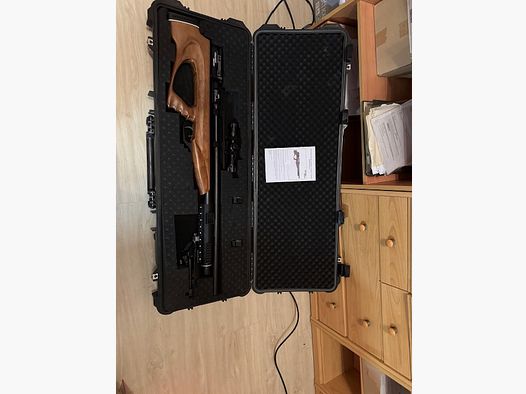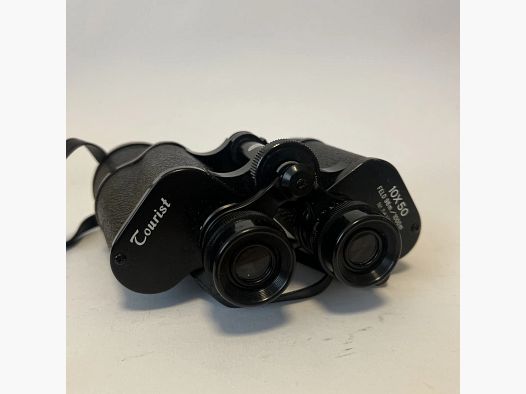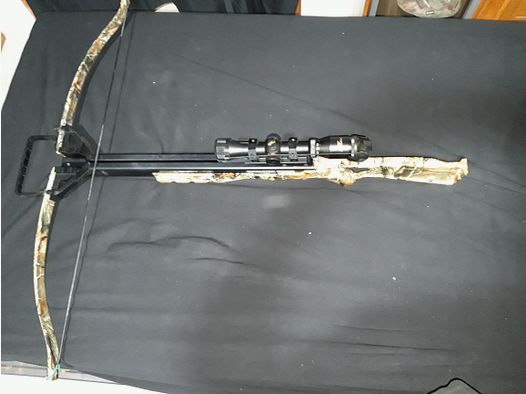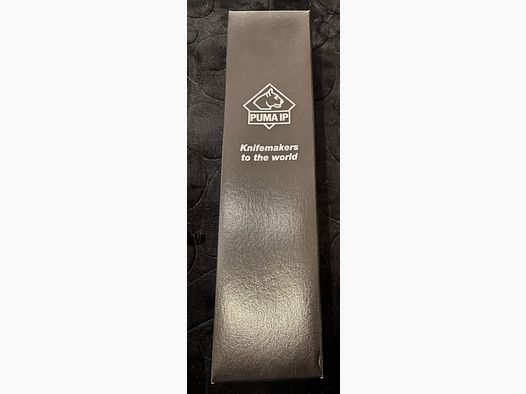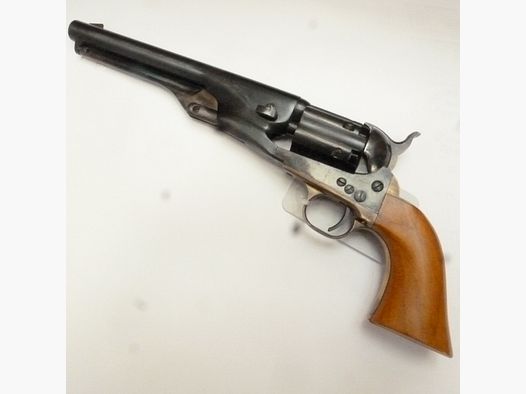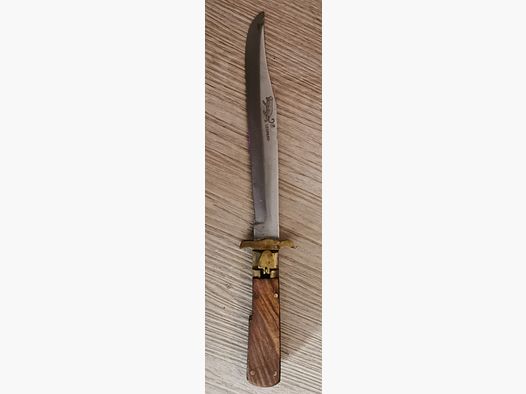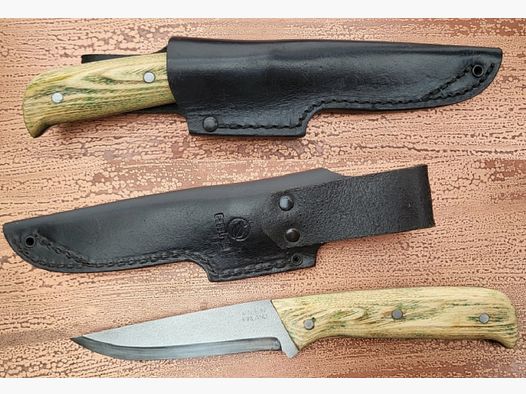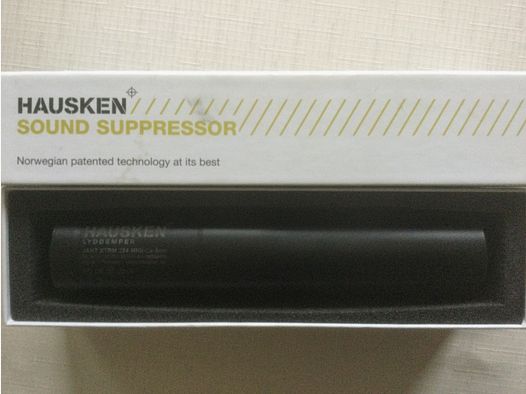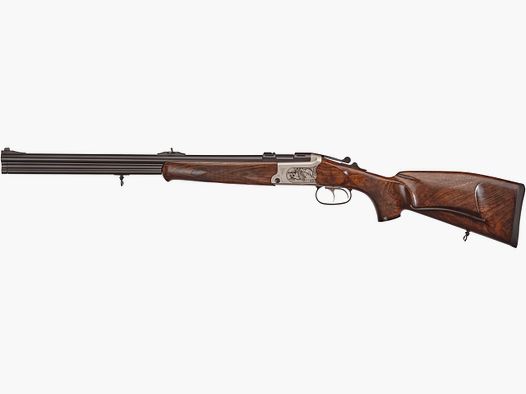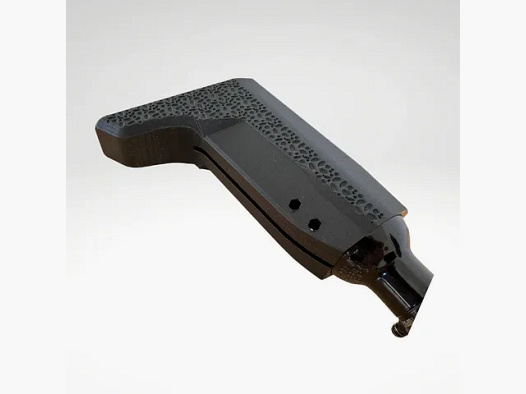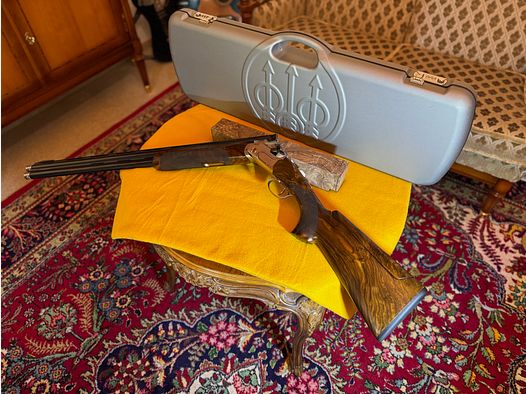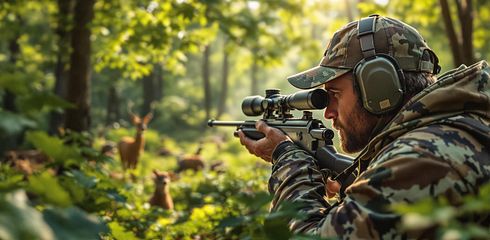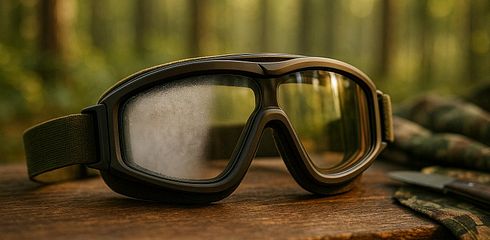Optics tests are crucial for hunters and shooters as they ensure that equipment such as riflescopes and safety glasses functions reliably even under extreme conditions. High-quality tests not only check image quality but also material stability, precision, and safety. Here are the key points:
- Safety glasses: Standards such as ANSI Z87.1 and MIL-PRF-32432A guarantee protection against high-speed impacts and extreme conditions.
- Riflescopes: Precision and mechanical reliability are often more important than pure image sharpness.
- Testing methods: Shock, drop, temperature, waterproofing, and precision tests are common methods.
- Standards: European standards such as DIN EN 166 and military standards like STANAG 2920 set clear requirements.
- Manufacturer methods: Brands like Zeiss, Schmidt & Bender, and Leupold conduct their own specialized tests.
Quick Comparison
| Testing Method | Strengths | Weaknesses | Practical Relevance |
|---|---|---|---|
| Military Standards | Strict requirements, robust | Less specific for sports | High for extreme use |
| ISO Standards | Comprehensive, internationally recognized | Time-consuming | Medium to high |
| Manufacturer Tests | Product-specific, innovative | Not standardized | Varies widely |
| Field Tests | Realistic, practice-oriented | Subjective, hard to reproduce | Very high |
Conclusion: Standardized tests and well-founded comparative data are essential for selecting the best optics for hunting and shooting sports. Platforms like Gunfinder help find and compare certified products.
BOXTEST for Hunters: How Precise is a Top Riflescope?
Common Optics Testing Standards Explained
Optics tests are a complex field that goes far beyond simple image quality checks. They ensure that your equipment functions reliably even under extreme conditions. All relevant aspects for hunters and shooters are taken into account. These testing methods implement the quality requirements described earlier and form the basis for international standards.
Main Testing Types
The most important testing methods include:
- Shock and recoil tests: These simulate the stresses that occur during shooting and test the durability of the optics. An example: Sightmark uses such tests to ensure the longevity of their riflescopes.
- Vibration tests: Here, the riflescope is tested in different frequency ranges to discover potential weaknesses.
- Drop tests: Optics are dropped from heights between 0.9 and 1.8 meters onto concrete to test their stability under impacts.
- Salt spray tests: These tests check corrosion resistance, which is particularly important in humid or coastal regions.
- Temperature and temperature change tests: Optics are exposed to extreme temperatures, from icy to hot conditions. Temperature change tests additionally examine whether the optics fog up during sudden temperature changes.
- Waterproof tests: This tests whether the optics remain sealed when submerged.
- Precision tests: Mechanical precision is tested through methods such as tall-target, tracking, and parallax adjustment tests.
Depending on the material and technology – whether glass, night vision, or thermal imaging devices – there are different testing procedures. Red dot and reflex sights are also tested similarly to riflescopes.
Industry Standards and Protocols
In Europe, DIN EN 166 forms the basis for eye protection. This standard relies on methods from EN 167, EN 168, and EN 170:
- EN 167 defines optical requirements and classifies refractive power into three categories. Class 1 offers the highest quality for continuous use.
- EN 168 establishes testing procedures for robustness, temperature stability, UV resistance, high-speed impact, and more.
- EN 170 regulates UV protection and the labeling of lenses.
Shooting glasses fall under the category of “Performance Eyewear” and are subject to strict regulations. EN 166F covers protection against low-energy impacts, while EN 166S addresses high-speed impact scenarios that can occur during shooting.
International standards are also important. In NATO countries, for example, STANAG 2920 and STANAG 4296 are used. These test eye protection against shrapnel and high-speed projectiles. In the STANAG 2920 test, a 3.6 mm caliber projectile is fired from a distance of 3.8 meters.
In the USA, the military standard MIL-PRF-32432 defines the requirements: Glasses must withstand a 0.15 caliber projectile with 5.85 grains at 195–201 m/s. Safety glasses are tested with a 0.22 caliber projectile at 167–170 m/s. The standard MIL-STD-810E complements this with tests that examine suitability for specific geographical and climatic conditions.
The differences between these standards are significant: Military tests like STANAG or MIL-PRF are about seven times stricter than civilian tests like ANSI Z87.1-2020. While safety glasses usually only meet the basic requirements of the ANSI Z87+ standard, shooting glasses often offer additional ballistic protection with military certification.
Additionally, Intertek conducts tests according to international standards such as ASTM, SAE, ISO/IEC, UL 50, and others. These comprehensive testing procedures highlight the specialization and complexity in this field.
For hunters and shooters in Germany, it is crucial to know these standards. They help ensure that the equipment not only meets legal requirements but also fulfills the highest safety standards. Aspects such as impact resistance, UV protection, and optical clarity are indispensable features.
How Different Manufacturers Test Their Optics
Large manufacturers develop their own testing procedures that go beyond the usual industry standards. They specifically focus on different aspects to highlight their products. These procedures help meet the criteria defined in the standards in practice.
Testing Methods of Major Brands
Zeiss has established a global network of Group Test Centers (GTC) in Aalen (Germany), Tijuana (Mexico), and Guangzhou (China) since 2010. The company has developed 24 proprietary testing methods and conducts a total of 36 chemical, thermal, and mechanical tests.
“The standards were originally developed for mineral glasses, but now ZEISS has different specifications for the wide range of plastic lenses currently available.”
In May 2019, the Group Test Center in Aalen received renewed DAkkS certification according to DIN EN ISO/IEC 17025. The Zeiss network serves more than 20 international customers from Europe, the USA, and Asia.
Schmidt & Bender focuses on manual adjustment and individual customization. Each riflescope is manufactured in-house and individually tuned. In a field test, the Schmidt & Bender PMII 5-25×56 consistently performed strongly in all categories.
Leupold stands out for its excellent customer service and comprehensive warranty offerings. The long-term reliability of the products is particularly emphasized.
European brands like Leica, Swarovski, and Zeiss impress with high performance and quality. A survey of over 700 readers found that mechanical performance is regarded as the most important feature, followed by optical performance.
These established testing methods are complemented by even more specialized and modern approaches.
Special Testing Techniques
In addition to the known procedures, modern manufacturers increasingly rely on innovative approaches. Zeiss uses its own developments such as the Bayer test, the water barrier test, and various exposure tests. These tests were introduced to cover requirements that go beyond the minimum specifications of industry standards.
Nightforce introduced new features such as the Double Turn Turret Design and a ½-click elevation adjustment switch with the BEAST 5-25×56 in 2013. This model was rated as the second best in tests and praised for its innovative features.
Kahles focuses on mechanical calibration and weight reduction. The K 6-24×56 performed well in field tests and was positively highlighted for its precise calibration and low weight.
A notable point from the test results: In an extensive field test, the difference in overall rating between the 16th and 61st percentile of the tested riflescopes was only 4%. This shows how closely the performance of many high-end optics is grouped.
“The overall philosophy when dealing with sights is: TAKE NOTHING FOR GRANTED! The most important thing is to work with absolute fundamentals, measure them, and eliminate all assumptions. Never assume that something is what it claims to be without measuring it.” - Bryan Litz, Applied Ballistics for Long-Range Shooting.
Additionally, manufacturers conduct EMC tests (Electromagnetic Compatibility) to ensure the functionality of their products. Safety tests for electrical devices, medical electrical devices, and optical instruments are also conducted according to international standards.
Comparison: Which Testing Methods Work Best?
Based on established testing standards, we take a look at which methods are most convincing in practice. Testing procedures vary widely in their reliability and significance. While some approaches are based on laboratory analyses, others provide practice-oriented results that are closer to real-world conditions. The following comparison shows which procedures prove themselves in practical use.
Comparison of Testing Standards
Military standards such as MIL-C-48497 offer structured abrasion tests that distinguish between moderate and intense use. Moderate tests assess durability during everyday cleaning and handling, while intense tests evaluate resilience under extreme conditions.
| Testing Method | Strengths | Weaknesses | Practical Relevance |
|---|---|---|---|
| Military Standards (MIL-Specs) | Clear minimum requirements, standardized procedures | Not very specific for hunting or shooting sports | High for extreme conditions |
| ISO Standards | Internationally recognized, comprehensive environmental tests | Time-intensive, not always practical | Medium to high |
| Manufacturer-Specific Tests | Product-specific, often innovative procedures | Not standardized, hard to compare | Varies widely |
| Field Tests | Realistic, practice-oriented results | Subjective, hard to reproduce | Very high |
A good example of the importance of batch control is LaCroix Precision Optics. The company routinely tests each coating for abrasion and adhesion and provides reference samples upon request. This approach underscores the importance of consistent quality in production.
“When you make optics, you have to be able to test the optics because you can't make optics better than you can test them.” - James C. Wyant, Professor of Optical Sciences, University of Arizona.
These different testing approaches provide the foundation for a well-founded assessment of long-term reliability.
Long-Term Reliability Assessment
A combination of laboratory tests, as described in MIL-STD-810E, and practice-oriented field tests provides valuable insights into long-term reliability. Richard Douglas conducted extensive tests on various riflescopes, including tracking tests at distances between 100 and 500 meters. The Leupold Patrol 6HD impressed with quick target acquisition, while the Nightforce SHV 4-14×50 was excluded due to its weight and bulky design despite its excellent glass quality.
“I have stressed these riflescopes in real hunting situations. Dropped them in creek beds, pushed through cedar thickets, and left them outside in freezing rain. Half of them couldn't keep up, but those that made it onto this list earned their place the hard way.” - Richard Douglas.
VLC Photonics also relies on extended reliability tests to meet increasing demands. With modern temperature and humidity testing equipment that meets ISO 9001 standards, the company ensures that its products perform under various conditions.
An experienced tester reports that after years of freezing optics and immersing them in hot water, he found that all optics passed these tests without failure. He no longer conducts these tests as he believes they do not reflect realistic conditions that most users experience in the field.
In addition to quantitative tests, mechanical performance plays a crucial role in practice. Experienced testers emphasize that mechanics are often more important than subjective visual assessments. An expert highlights that tracking accuracy is critical and that mechanics should be prioritized.
“People who want to test the glass or worry about the 'look' of the riflescope have their priorities wrong.” - Lowlight, moderator at Snipershide.com.
sbb-itb-1cfd233
Practical Guide for Hunters and Shooters
The proper evaluation of test results and a wise product selection are crucial for success in the field. While laboratory values provide helpful insights, the key lies in interpreting this data meaningfully and aligning it with one's own requirements.
Understanding and Utilizing Test Results
For many hunters, a magnification of 4–6 times is sufficient for deer hunting at distances of 100–200 meters. Higher magnifications can make details more visible but often lead to disadvantages such as chromatic aberration, image distortion, a restricted field of view, and darker images. A larger objective lens can capture more light but also increases weight and cost. Often, high-quality lens coatings make more difference than just a larger objective lens.
Precision shooters, on the other hand, should pay special attention to the standard deviation (SD) of the muzzle velocity. In a PRS competition, 75% of participants had an SD below 10.4 fps. A comparison of the median values shows: The upper half of participants achieved SD values of 6.7 fps or less, while the values of the lower half ranged between 7.8 and 8.4 fps.
An analysis of the effective target probability (WEZ) found that reducing the SD from 20 fps to 5 fps could increase the hit probability at 945 meters by 24%. However, Bryan Litz from Applied Ballistics points out:
“Every time I talk about WEZ, I point out that the hit percentage is based on inputs that typically characterize the uncertainties of the first shot. After you fire and observe the first shot and apply the feedback, you effectively eliminate all variables except MV SD, BC SD, and group sizes.”
In addition to optical performance, legal and certification-related requirements are of great importance.
Legal and Certification Requirements
In Germany, there are clear guidelines for optics in hunting and shooting sports. The ANSI Z87.1 certification is considered the leading standard for shooting glasses. It guarantees protection against impacts, optical quality, and safety in hazardous situations.
However, military standards are even stricter. Safety glasses must withstand a 0.15 caliber projectile with 5.8 grains at 195–201 m/s. This corresponds to a load that is about seven times higher than that of the ANSI Z87.1-2020 high-speed impact test.
The NATO standard STANAG 4296 defines the requirements for military safety glasses. These must be lightweight and comfortable, provide a large field of view, be resistant to fogging and scratches, and be compatible with other protective equipment. Impact protection is based on STANAG 2920.
For selecting suitable optics, Gunfinder offers helpful support.
Gunfinder: Your Platform for Optics Comparison
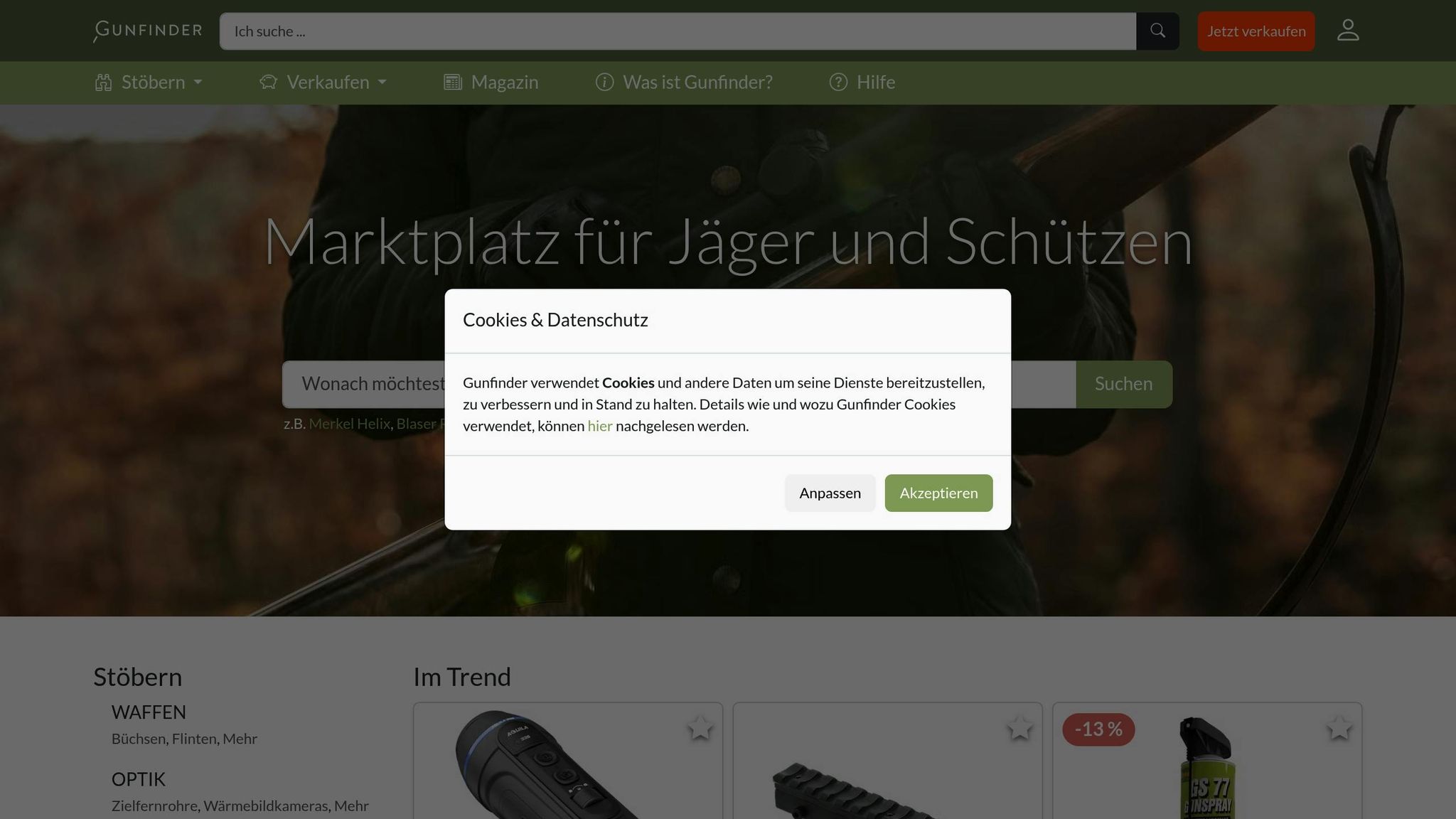
Gunfinder makes the search for the ideal optics easier. With search and filter functions, you can specifically look for devices such as riflescopes, red dot sights, or binoculars. The filter options allow selection by brand, category, and other criteria.
In the product descriptions, you will find details on test results, certifications, and standards. If certain information is missing, you can contact the seller directly through the platform.
A major advantage of Gunfinder is the ability to compare specifications and features of different products directly. For example, you can view the light transmission, mechanical precision, or coating quality of riflescopes side by side. Particularly interesting is that you can discover both new and used optics. High-quality brands like Zeiss, Swarovski, or Schmidt & Bender are often a cost-effective alternative when used, without compromising optical performance.
Conclusion: The Key Insights from the Optics Test Comparison
Testing methods vary widely in their significance. While some procedures provide helpful insights, others are less relevant in practice.
Why Clear Testing Standards Are Indispensable
Standardized tests are particularly important when it comes to mechanical precision. Riflescopes rated “PASS” maintain their adjustment even after drop tests within 2%. In contrast, “PARTIAL FAIL” models show deviations of over 2% and lose their zero point.
Scott Einsmann, an experienced optics testing expert, puts it aptly:
“The one thing I don’t do is submerge riflescopes, freeze them, and then thaw them out. I have learned through many years of optics testing that only a vanishingly small percentage of riflescopes fail under this kind of torture test, and I prefer to spend my time on more meaningful evaluations.”
This statement illustrates that practical tests often provide more benefit than spectacular extreme tests. Evaluating optical properties such as resolution and low-light performance, as well as checking turret and reticle tracking, provides valuable information for hunters and shooters.
In addition to these mechanical tests, modern laser sighting devices show impressive advances. Independent studies show that calibrated laser sights can double shooting accuracy and reduce target acquisition time by up to 50%. This technology minimizes sources of error by projecting a clear target point directly onto the target surface.
Informed Purchase Decisions Through Test Data
Well-analyzed test data can make the difference between a good and an excellent purchase. A crucial factor is zero point retention. ChrisAU from WKR emphasizes: “Zero Retention Matters.” Even the best glass quality is of little use if the optics do not reliably maintain their zero point. Therefore, pay attention to precise adjustments that ensure zero point stability.
Such test data helps you make informed decisions – this is where Gunfinder comes into play. The platform offers detailed product descriptions and comparison options that help you identify the test criteria relevant to your needs. This turns a multitude of technical details into a clear recommendation that perfectly fits your application.
FAQs
Which testing criteria are particularly important when selecting safety glasses and riflescopes in hunting and shooting sports?
For safety glasses, impact resistance is a crucial criterion. Glasses with polycarbonate lenses offer excellent protection and meet strict safety requirements. It is important to ensure that the glasses have been tested according to recognized standards.
For riflescopes, quality and reliability are paramount. Although there are no uniform testing standards in Germany, manufacturer specifications and independent tests can provide helpful guidance. Important aspects to consider include light transmission, shot resistance, and resistance to weather influences. These features are essential for selecting a precise and durable model.
How do the testing procedures of major optics manufacturers like Zeiss, Schmidt & Bender, and Leupold differ?
The Testing Procedures of Zeiss, Schmidt & Bender, and Leupold
The testing methods of manufacturers Zeiss, Schmidt & Bender, and Leupold each focus on different aspects to optimally tailor their products to the needs of hunters and shooters.
- Zeiss impresses with state-of-the-art optical technology and excellent image quality that performs well even in difficult lighting conditions.
- Schmidt & Bender places particular emphasis on precise parallax adjustment and an extremely robust construction that withstands even the toughest conditions.
- Leupold relies on durable materials and offers clear, reliable optics that meet the needs of demanding users.
Although the exact testing standards vary between manufacturers, they all pursue a common goal: to test their products under realistic conditions and ensure consistently high quality. If you are looking for the perfect optics, it is worth checking out platforms like Gunfinder, which offer a wide selection of high-quality models.
Why are field tests more important than lab tests when it comes to evaluating optics?
Why Field Tests Are Indispensable
Field tests play a crucial role in testing optics under real conditions. While lab tests simulate standardized scenarios, field tests show how the optics actually perform in practice – whether in changing weather, extreme temperatures, or intense use.
These practical tests provide valuable insights into the reliability and performance of the optics, especially for hunting and sporting use. This way, you can be sure that your equipment functions reliably even in the most challenging situations.



